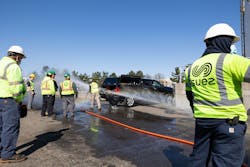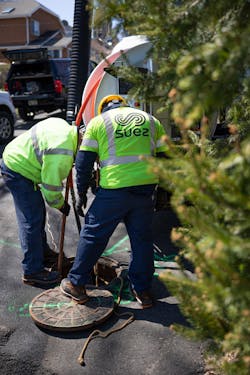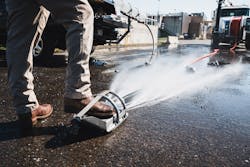Operators cleaning municipal sewer, storm and sanitary lines face a host of challenges on the job. This can range from having to clean miles of line in the most efficient manner, to complying with annual regulatory mandates, or handling tough blockages caused by roots, grease, and cave-ins.
“Most of these problems occur in four-inch up to 18-inch sewer pipe, which accounts for up to 95 percent of all the pipe in the ground anywhere in the United States,” said Dan Story, operations manager for KEG Technologies, a manufacturer of sewer and storm lines products including Tier 1 to Tier 3 nozzles, chain cutters, floor cleaners and camera nozzle systems. “Proper training and education can resolve the majority of these issues.”
To Clean Faster, Slow Down
The number one mistake made by most operators is simply rushing through the cleaning process, Story said.
“Most operators run their nozzles way too fast. Slow your nozzle down and let it do its job. You’re not in a race. If you run the nozzle up in a hurry and back in a hurry, all you do is waste water and time,” he said.
When operators slow down and let the water flow carry the material back to the evacuation point, the water in the pipe becomes like a “conveyor belt that moves the material.”
With six to 15-inch lines, 95 percent of the time it is possible to go from manhole to manhole and clean them in one pass using this method.
To stay productive, Story advises operators to never outrun their water.
“As you go in the pipe, if you go in slow enough, you should be running between 40 and 60 feet per minute, based on the condition of the pipe and how much material is in the pipe. The more material, the slower you want to move,” he said.
“You want to be able to chop that material up and get it in the flow of the pipe’s stream. When you get to the end of the line, dial your pressure back down and rinse it. When you come back, the job is done.”
Choose the Right Nozzle
In addition to going slow, Story emphasizes choosing the right nozzle for the job.
Nozzles are rated for water efficiency from Tier 1 (about 30 percent efficiency), to Tier 2 (50-60 percent efficiency), and Tier 3 (75-98 percent efficiency). Lower levels of efficiency could result in additional trips to refill. Additionally, such units may not remove restrictive sewer buildup or blockage in a timely manner.
According to Story, a Tier-1, 30-degree drilled nozzle running 72 gallons a minute at 2,200 PSI will only exert 13 pounds of force to move debris nine feet away from the nozzle. In contrast, a Tier-3 nozzle running 60 gallons a minute at 2,000 PSI will impact that blockage nine feet away with 98 pounds of force.
“If your objective is to remove debris out of the sewer line, using high-efficiency Tier-3 nozzles are key to getting more done in less time,” Story said.
Slow Down Even More to Remove Blockages
While blockages come in many varieties, including roots, grease, mineral deposits, and cave-ins, it is essential to clean even slower when encountering one, according to Story.
“If the operator rushes up the sewer line, sooner or later they will run into a blockage of roots, grease, etc., and plug up their front jets. Now, they no longer have a penetrating tool. They have a battering ram, a nozzle with no forward jets trying to feed its way through the blockage,” said Story.
He advises, “Instead, slow down even more to remove a blockage and let the nozzle do the work. The reason we put forward jets on those nozzles is so they can open the blockage before the nozzle arrives. By slowing it down, the water will open the blockage even before the nozzle ever gets there.”
Set Up and Use Chain Cutters Correctly
Chain cutters can be used to remove most types of sewer line blockages. As an example, high output torque cutters such as KEG’s Micro Chain Cutter can readily remove light roots, while its Supernova Chain Cutter is designed to eliminate heavy root blockages as well as scale, mineral deposits, and years of hardened grease.
However, these tools must be set up and used correctly.
“Chain cutters are forgiving, but most people are hesitant to use them because if they are set up wrong or run improperly, they can destroy your pipe. If you set it up right, and run it properly, you will never damage a pipe,” said Story.
Story said that operators must first set up cutters correctly and follow the manufacturer’s guidelines. In general, he advises, it is best to set up the cutter chain to be about one inch smaller than the pipe it will cut (i.e., use a 9-inch cutter chain in a 10-inch pipe, etc.)
As for operating the cutter, he said, “Let the tool find its way down. You will know when it’s in contact with roots. You can feel it. You can smell it. You can hear the change in the way that the tool works. Just keep feeding it in slow and steady until it gets through the problem.”
Use a Camera Nozzle to Quickly Determine the Problem
When municipalities need to quickly assess the condition of a sewer line to determine a solution or document its condition to verify mandated compliance, nozzles with integrated cameras can accomplish both during routine cleaning exercises.
“A small municipality could use a camera-nozzle to inspect their own pipes to verify they are clean instead of contracting it out. [Then] if they found any major problems, they could bring their contractor in,” said Ken Billingham, KEG International product specialist.
“Anytime you put a root cutter
in any kind of pipe, the line should always be inspected with a camera first, and a camera nozzle makes this easy. Also, all cutting should be done with a camera to help the operator know what he or she is doing. This is critical because with all the varied utilities in the ground, if you’re not inspecting the pipe, you’re liable to hit electric lines, gas lines, or fiber optic lines — and that can cause explosions or serious outages.” WW
About the Author: Del Williams is a technical writer based in Torrance, Calif.


